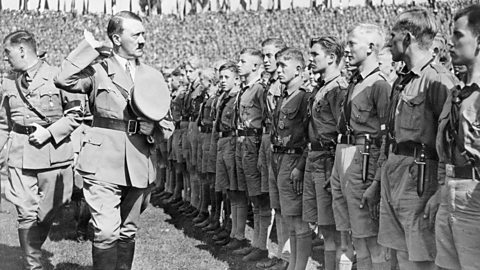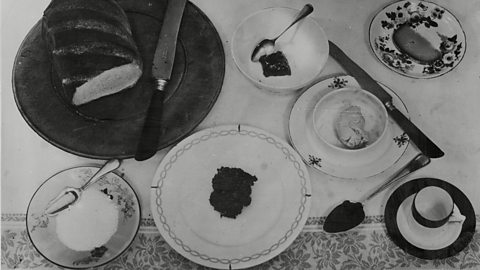Introduction

HitlerÔÇÖs main ways of indoctrinateTeaching a set of beliefs weighted towards a particular point of view. and controlling young people were through:
- Education
- Youth movements
- Propaganda and censorship
Education
Schools and universities were to:
- indoctrinateTeaching a set of beliefs weighted towards a particular point of view. young people into the racial ideas of Nazism and make children loyal to Hitler - this was in effect a form of brainwashing.
- Train girls to be good AryanA person of European descent - not Jewish - often with blond hair and blue eyes. The Nazis viewed Aryans as the superior human race. wives and mothers, and prepare boys to be effective soldiers.
- Make young people ÔÇ£swift as a greyhound, as tough as leather, and as hard as Krupp steelÔÇØ.
Teachers
All teachers had to join the Nazi TeachersÔÇÖ Association, which vetted them for political and racial suitability.
Textbooks
Textbooks were rewritten, especially in history and biology, to promote GermanyÔÇÖs 'greatness', Aryan 'supremacy' and anti-semitismHostility or prejudice against Jews..
Curriculum
The curriculumA collection of subjects that make up the course of study at a school or college. in schools was altered to reflect Nazi ideologyA set of beliefs about how a country, or system, should work. and priorities.
- The importance put on subjects like chemistry and mathematics was reduced.
- By the end of the 1930s, religious education was banned.
- Fitness was vital so children had at least five one-hour sessions of physical education (PE) every week, often for two hours per day.
- eugenicsThe science of using controlled breeding or genetic manipulation to produce desired qualities or features. (race studies) was added to the curriculum.
- Boys mostly studied history, eugenics and PE. Boxing was compulsory.
- Girls primarily studied home economics, eugenics and PE.
Jewish children were humiliated at school and then, in 1938, banned from education.
Adolf Hitler Schools
Boys with potential to be future leaders were sent to special Adolf Hitler Schools. These were free boarding schools, run on military lines, for boys aged 12 to 18 years.
Castles of Order were set up for young men of talent, usually in their mid-twenties. There they completed their military and leadership training. Live ammunition was used and the frequent endurance tasks were brutal.
Youth organisations in Nazi Germany

In 1933, the Hitler YouthNazi organisation set up to convert GermanyÔÇÖs young people to Nazism. took over all youth movements in Germany, except Catholic ones - which were eliminated in 1936.
The Youth Law in 1936 made membership practically compulsory for Hitler Youth.
The HJ aimed to:
- Control the activities of young people outside the classroom.
- Make them loyal to Hitler.
- Train boys to be soldiers and prepare girls to be wives and mothers.
- There were separate organisations for boys and girls, and for different age groups.
There were also different activities for boys and girls, although both undertook fitness and indoctrination classes.
- Boys enrolled in the movement at six years old, and joined the main group, Hitler Youth (HJ), at 14. By 1939, 90% of German boys aged 14 and over were members.
- Boys fired guns and marched in preparation for the army.
- Girls enrolled in the movement at the age of ten. They moved into the main wing, the League of German Maidens (BDM), at the age of 14.
- Girls learnt how to look after a family.

The impact of Nazi actions and policies on young people
Positives
- Young people got to experience a range of new activities, like hiking weekends, in the Hitler YouthNazi organisation set up to convert GermanyÔÇÖs young people to Nazism..
- They had more freedom from their parents. Slogans like ÔÇ£Youth must be led by youthÔÇØ appealed to them.
Negatives
- The quality and breadth of education in schools deteriorated.
- Girls' educational opportunities decreased. Their curriculumA collection of subjects that make up the course of study at a school or college. was limited to home-making subjects and very few went to university by 1939.
- Jewish children were persecuted at school and then excluded.
The effectiveness of Nazi actions and policies by 1939
The NazisÔÇÖ youth policies had mixed results.
Successes
- Seven million joined the Hitler YouthNazi organisation set up to convert GermanyÔÇÖs young people to Nazism. movement.
- Most young people did not oppose the Nazis. Indeed, many obeyed the Nazis rather than their parents.
- Germany had a more disciplined youth than in other European countries.
- The Nazis succeeded in ending most rival organisations, such as the Catholic Youth Movement in 1936.
Failures
- Some young people established their own rival groups, such as the Edelweiss Pirates, the Jazz Group and the Swing Group.
- Young people became more disillusioned with the youth movements as the years passed.
- Indoctrination was not totally effective. It reinforced existing beliefs but was less successful in getting young people to accept new ideas.
Test your knowledge
More on Life in Nazi Germany, 1933-45
Find out more by working through a topic
- count7 of 7
